How To Proceed With Troubleshooting
CAUTION / NOTICE / HINT
HINT:
- The ECM is connected to the CAN communication system. Therefore, before
starting troubleshooting, make sure to check that there are no
malfunctions in the CAN communication system.
- *: Use the Techstream.
PROCEDURE
|
1. | VEHICLE BROUGHT TO WORKSHOP |
|
NEXT |
 | |
| 2. |
CUSTOMER PROBLEM ANALYSIS |
|
NEXT |
 | |
| 3. |
INSPECT BATTERY VOLTAGE |
Standard Voltage:
11 to 14 V
If the voltage is below 11 V, recharge or replace the battery before proceeding.
|
NEXT |
 | |
| 4. |
CONNECT TECHSTREAM TO DLC3* |
|
NEXT |
 | |
| 5. |
CHECK AND CLEAR DTCS AND FREEZE FRAME DATA* |
(a) Refer to DTC Check / Clear.
Click here

|
NEXT |
 | |
|
NEXT |
 | |
| 7. |
SELECT CHECK MODE DIAGNOSIS* |
(a) Refer to Check Mode Procedure.
Click here 
|
NEXT |
 | |
| 8. |
PROBLEM SYMPTOM CONFIRMATION |
(a) Refer to Road Test.
Click here 
|
Result | Proceed to |
|
Symptom does not occur |
A |
| Symptom occurs |
B |
| B |
 | GO TO STEP 10 |
|
A |
 | |
(a) Refer to Symptom Simulation.
Click here 
|
NEXT |
 | |
(a) Refer to DTC Check / Clear.
Click here 
|
Result | Proceed to |
|
DTCs are not output | A |
|
DTCs are output | B |
| B |
 | GO TO STEP 20 |
|
A |
 | |
(a) Refer to Park/Neutral Position Switch.
Click here 
(b) Refer to Transmission Control Cable.
Click here 
| NG |
 | GO TO STEP 18 |
|
OK |
 | |
| 12. |
MECHANICAL SYSTEM TESTS |
(a) Refer to Mechanical System Tests.
Click here 
| NG |
 | GO TO STEP 17 |
|
OK |
 | |
(a) Refer to Hydraulic Test.
Click here 
| NG |
 | GO TO STEP 17 |
|
OK |
 | |
(a) Refer to Manual Shifting Test.
Click here 
| NG |
 | GO TO STEP 16 |
|
OK |
 | |
| 15. |
PROBLEM SYMPTOMS TABLE CHAPTER 1 |
(a) Refer to Problem Symptoms Table.
Click here 
| NG |
 | GO TO STEP 21 |
|
OK |
 | |
| 16. |
PROBLEM SYMPTOMS TABLE CHAPTER 2 |
(a) Refer to Problem Symptoms Table.
Click here 
|
NEXT |
 | |
|
NEXT |
 | |
|
NEXT |
 | |
| NEXT |
 | END |
(a) Refer to Diagnostic Trouble Code Chart.
Click here 
|
NEXT |
 | |
|
NEXT |
 | |
| 22. |
IDENTIFICATION INFORMATION |
| NEXT |
 | GO TO STEP 18 |
Hydraulic Test
HYDRAULIC TEST
PERFORM HYDRAULIC TEST
CAUTION:
- Do not perform a stall test if there are any people or objects near the vehicle.
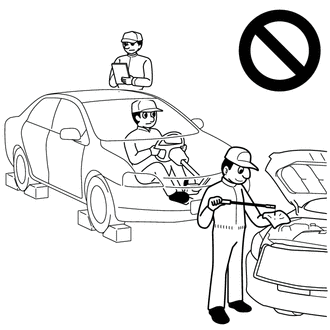
- The vehicle could begin moving suddenly, resulting in a serious accident.
- Do not perform a stall test if any wheel chocks are out of position.
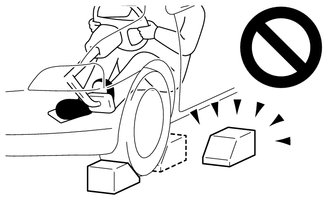
- The vehicle could begin moving suddenly, resulting in a serious accident.
- Do not perform the stall test on a slippery or low-friction surface that could allow the tires to spin.
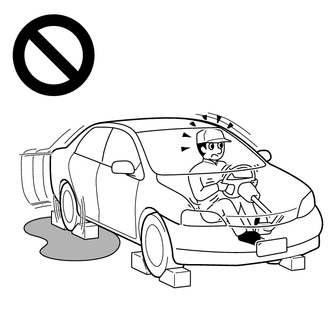
- The vehicle could begin moving suddenly, resulting in a serious accident.
(a) Measure the line pressure.
NOTICE:
- Perform this test with the ATF (Automatic Transaxle Fluid) at the normal operating temperature: 50 to 80°C (122 to 176°F)
- Be careful to prevent the SST hose from contacting the exhaust pipe.
- This check must be conducted after checking and confirming that the engine is normal.
- Perform this test with the air conditioning off.
- Do not perform the stall test for longer than 5 seconds.
- When performing the stall speed test repeatedly, wait for 15 seconds or more between tests.
- The installation position of SST is different for the D position and R position line pressure tests.
- Perform this test with the AUTO function (shift-linked function) of the electronic parking brake system off.
(1) Warm up the ATF.
(2) Lift the vehicle.
(3) Remove the engine under cover.
(4) Remove the test plug A on the front side of the transaxle case and install SST.
SST: 09993-19015
09993-00010
09993-00040
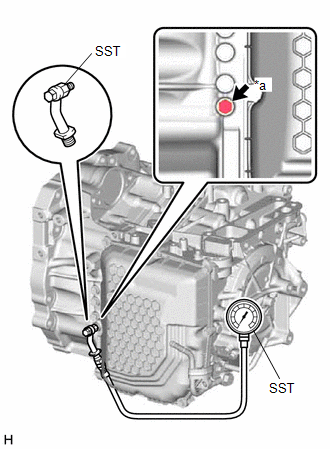
(5) Lower the vehicle.
(6) Fully apply the parking brake and chock all 4 wheels.
HINT:
When
the parking brake indicator (red) is illuminated after the electric
parking brake switch (electric parking brake switch assembly) has been
pulled to the lock side, the maximum amount of braking force is applied
if the electric parking brake switch (electric parking brake switch
assembly) is pulled to the lock side one more time.
(7) Start the engine and check the idle speed.
(8) Keep your left foot firmly on the brake pedal and move the shift lever to D.
(9)
Depress the accelerator pedal as much as possible with your right foot.
Quickly read the highest line pressure reading when the engine speed
reaches stall speed.
Specified Line Pressure:
|
Condition | D Position |
|
Stall test | 1300 to 1600 kPa
(13.3 to 16.3 kgf/cm2, 189 to 232 psi) |
(10) Turn the engine switch off.
(11) Remove SST and install the test plug A.
(12) Remove the test plug B on the left side of the transaxle case and install SST.
SST: 09993-19015
09993-00010
09993-00040
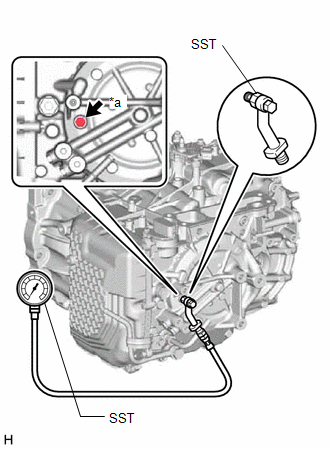
(13) Start the engine and check the idle speed.
(14) Keep your left foot firmly on the brake pedal and move the shift lever to R.
(15)
Depress the accelerator pedal as much as possible with your right foot.
Quickly read the highest line pressure reading when the engine speed
reaches stall speed.
Specified Line Pressure:
|
Condition | R Position |
|
Stall test | 1700 to 2100 kPa
(17.3 to 21.4 kgf/cm2, 247 to 305 psi) |
(16) Turn the engine switch off.
(17) Remove SST and install the test plug B.
(18) Clear the DTCs.
Click here 
Evaluation |
Problem | Possible Cause |
|
Measured values at all positions are higher than specified |
- Solenoid (SLT) valve defective
- Regulator valve defective
|
| Measured values at all positions are lower than specified |
- Solenoid (SLT) valve defective
- Regulator valve defective
- Oil pump defective
|
| Pressure is low when shift lever is in D only |
- D position circuit fluid leak
- No. 1 clutch (C1) defective
- No. 2 brake (B2) defective
|
| Pressure is low when shift lever is in R only |
- R position circuit fluid leak
- No. 3 clutch (C3) defective
- No. 2 brake (B2) defective
|
Initialization
INITIALIZATION
RESET TRANSAXLE COMPENSATION CODE
NOTICE:
- If the following parts have been replaced, initialize the ECM, perform Reset Memory and Perform Road Test to Allow ECM to Learn.
- ECM (When transaxle compensation code cannot be transferred.)
- Transmission valve body assembly
- Solenoid (SL1) valve
- Solenoid (SL2) valve
- Solenoid (SL3) valve
- Solenoid (SL4) valve
- Solenoid (SL5) valve
- Solenoid (SL6) valve
- The transaxle compensation code can only be initialized with the Techstream.
HINT:
The ECM (ECT) memorizes the vehicle conditions when controlling the automatic transaxle assembly and engine assembly.
Therefore,
if the automatic transaxle assembly or ECM has been replaced, it is
necessary to reset the memory so that the ECM can memorize the new
information. The reset procedure is as follows:
(a) Make sure the shift lever is in P or N.
(b) Connect the Techstream to the DLC3.
(c) Turn the engine switch on (IG).
(d) Turn the Techstream on.
(e) Enter the following menus: Powertrain / Transmission / Utility / A/T Code Reset.
Powertrain > Transmission > Utility
|
Tester Display |
| A/T Code Reset |
(f) Press "Next" again to proceed.
NOTICE:
After the transaxle compensation code is initialized, perform Reset Memory and Perform Road Test to Allow ECM to Learn.
(g) Press "Exit".
RESET MEMORY
NOTICE:
- Perform Reset Memory (AT initialization) after replacing the automatic
transaxle assembly, transmission valve body assembly or any of the
solenoid (SL1, SL2, SL3, SL4, SL5 and/or SL6) valves.
- Reset Memory can only be performed with the Techstream.
- Reset Memory cannot be completed by only disconnecting and reconnecting the cable to the negative (-) battery terminal.
HINT:
The ECM (ECT) memorizes the vehicle conditions when controlling the automatic transaxle assembly and engine assembly.
(a) Connect the Techstream to the DLC3.
(b) Turn the engine switch on (IG).
(c) Turn the Techstream on.
(d) Enter the following menus: Powertrain / Transmission / Utility / Reset Memory.
Powertrain > Transmission > Utility
|
Tester Display |
| Reset Memory |
(e) Press "Next".
NOTICE:
After performing Reset Memory, be sure to perform Perform Road Test to Allow ECM to Learn.
PERFORM ROAD TEST TO ALLOW ECM TO LEARN
CAUTION:
- Perform the following procedures while strictly observing all traffic laws and speed limits.
- Do not accelerate or decelerate rapidly.
(a) The "road test" procedure is as follows:
(1) Warm up the engine.
(2) According to the replaced parts, perform the appropriate road test shown below.
|
Replaced Parts | Road Test |
- Automatic transaxle assembly
- ECM
- Transmission valve body assembly
- Solenoid (SL1) valve
- Solenoid (SL2) valve
- Solenoid (SL3) valve
- Solenoid (SL4) valve
- Solenoid (SL5) valve
- Solenoid (SL6) valve
- Engine assembly
| Perform pattern
- With the shift lever in D, after gradually accelerating to 85 km/h (53
mph) or more, gradually decelerate to approximately 20 km/h (12 mph).
|
HINT:
- After gradually accelerating over a distance of approximately 220 m
(721.9 ft.) for a period of approximately 20 seconds, gradually
decelerate over a distance of approximately 200 m (656.2 ft.) for a
period of approximately 20 seconds.
- When decelerating, apply the brakes as necessary to adjust the vehicle speed.
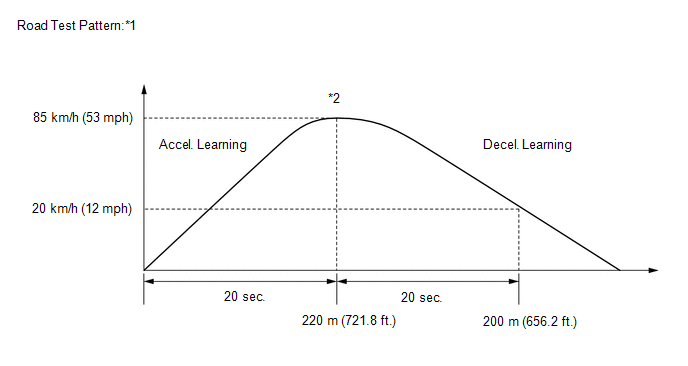
NOTICE:
- *1: The speed, time and distance values are approximate values.
- *2: After accelerating, deceleration does not need to be performed immediately.
(3) Repeat the road test until the
shift shock and engine speed overrun (engine speed flare when shifting)
reach an acceptable level.
NOTICE:
When
repeating the acceleration/deceleration cycle of a road test pattern,
bring the vehicle to a complete stop before accelerating again.
PERFORM ATF THERMAL DEGRADATION ESTIMATE RESET
NOTICE:
If either of the following conditions is met, perform ATF Thermal Degradation Estimate Reset:
(a) Turn the engine switch off.
(b) Connect the Techstream to the DLC3.
(c) With the shift lever in P, turn the engine switch on (IG).
NOTICE:
Do not start the engine.
(d) Turn the Techstream on.
(e) Enter the following menu: Powertrain / Transmission / Utility / ATF Thermal Degradation Estimate Reset.
Powertrain > Transmission > Utility
|
Tester Display |
| ATF Thermal Degradation Estimate Reset |
(f) According to the display on the Techstream, initialize the estimated thermal degradation value.
















































